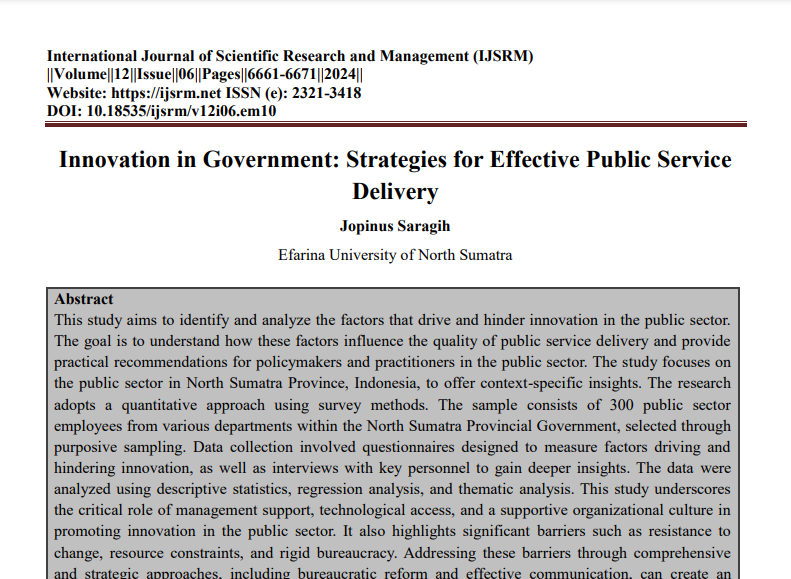
Submission to VIJ 2024-06-15
Keywords
- Bureaucracy,
- Innovation,
- Public Sector,
- Resource Management,
- Technological Access
Copyright (c) 2024 Jopinus Saragih

This work is licensed under a Creative Commons Attribution 4.0 International License.
Abstract
This study aims to identify and analyze the factors that drive and hinder innovation in the public sector. The goal is to understand how these factors influence the quality of public service delivery and provide practical recommendations for policymakers and practitioners in the public sector. The study focuses on the public sector in North Sumatra Province, Indonesia, to offer context-specific insights. The research adopts a quantitative approach using survey methods. The sample consists of 300 public sector employees from various departments within the North Sumatra Provincial Government, selected through purposive sampling. Data collection involved questionnaires designed to measure factors driving and hindering innovation, as well as interviews with key personnel to gain deeper insights. The data were analyzed using descriptive statistics, regression analysis, and thematic analysis. This study underscores the critical role of management support, technological access, and a supportive organizational culture in promoting innovation in the public sector. It also highlights significant barriers such as resistance to change, resource constraints, and rigid bureaucracy. Addressing these barriers through comprehensive and strategic approaches, including bureaucratic reform and effective communication, can create an environment conducive to innovation. This, in turn, can enhance the quality of public services and meet the increasingly complex needs of society. The findings provide valuable insights for policymakers and public sector managers aiming to foster sustainable innovation and improve public service delivery.
References
- Albury, D. (2005). Fostering innovation in public services. Public Money & Management, 25(1), 51–56.
- Barczak, G., Lassk, F., & Mulki, J. (2010). Antecedents of team creativity: An examination of team emotional intelligence, team trust, and collaborative culture. Creativity and Innovation Management, 19(4), 332–345. https://doi.org/https://doi.org/10.1111/j.1467-8691.2010.00574.x
- Borins, S. (2001). Encouraging innovation in the public sector. Journal of Intellectual Capital, 2(3), 310–319. https://doi.org/https://doi.org/10.1108/14691930110400128
- Borins, S. (2014). The persistence of innovation in government: A guide for innovative public servants. Brookings Institution Press.
- Creswell, J. W. (2014). Research Design: Qualitative, Quantitative and Mixed Methods Approaches. SAGE Publications, Inc.
- Damanpour, F., & Schneider, M. (2009). Characteristics of innovation and innovation adoption in public organizations: Assessing the role of managers. Journal of Public Administration Research and Theory, 19(3), 495–522. https://doi.org/https://doi.org/10.1093/jopart/mun021
- Danu, D. E. A., Supardi, S., Sutanto, S. T. J. P., & Riko, R. S. (2023). E-Services: Implementation of digital-based public services in the 4.0 era. Athena: Journal of Social, Culture and Society, 1(3), 87–92. https://doi.org/10.58905/athena.v1i3.40
- Drechsler, W. (2018). ‘Pathfinder: e-Estonia as the β-version. Journal of E-Democracy and Open Government (JeDEM), 16(1), 56–67.
- European Commission. (2013). Powering european public sector innovation: Towards a new architecture. Publications Office of the European Union.
- Fu, J. S., Shumate, M., & Contractor, N. (2020). Organizational and individual innovation decisions in an interorganizational system: Social influence and decision-making authority. Journal of Communication, 70(4), 497–521. https://doi.org/https://doi.org/10.1093/joc/jqaa018
- Hartley, J. (2005). Innovation in governance and public services: Past and present. Public Money & Management, 25(1), 27–34.
- Isaksen, S. G. (2017). Leadership’s role in creative climate creation. In Handbook of Research on Leadership and Creativity (pp. 131–158). https://doi.org/10.4337/9781784715465.00014
- Margetts, H., & Dunleavy, P. (2013). The second wave of digital-era governance: A quasi-paradigm for government on the web. Philosophical Transactions of the Royal Society A: Mathematical, Physical and Engineering Sciences, 371(1987), 20120382. https://doi.org/http://dx.doi.org/10.1098/rsta.2012.0382
- Martensen, A., & Dahlgaard, J. J. (1999). Strategy and planning for innovation management – supported by creative and learning organisations. International Journal of Quality & Reliability Management, 16(9), 878–891. https://doi.org/https://doi.org/10.1108/02656719910289177
- Martins, E. C., & Terblanche, F. (2003). Building organisational culture that stimulates creativity and innovation. European Journal of Innovation Management, 6(1), 64–74. https://doi.org/https://doi.org/10.1108/14601060310456337
- Mazzucato, M., & Semieniuk, G. (2017). Public financing of innovation: New questions. Oxford Review of Economic Policy, 33(1), 24–48. https://doi.org/https://doi.org/10.1093/oxrep/grw036
- Moore, M. H., & Hartley, J. (2008). Innovations in governance. Public Management Review, 10(1), 3–20. https://doi.org/http://dx.doi.org/10.1080/14719030701763161
- Mulgan, G., & Albury, D. (2003). Innovation in the public sector. Strategy Unit, Cabinet Office. https://www.sba.gov/sites/default/files/files/rs373tot.pdf
- OECD. (2017). Fostering innovation in the public sector. OECD Publishing.
- Oreg, S., Vakola, M., & Armenakis, A. (2011). Change recipients’ reactions to organizational change: A 60-year review of quantitative studies. Journal of Applied Behavioral Science, 47(4), 461–524. https://doi.org/https://psycnet.apa.org/doi/10.1177/0021886310396550
- Osborne, S. P., & Brown, L. (2011). Innovation, public policy and public services delivery in the UK: The word that would be king? Public Administration, 89(4), 1335–1350. https://doi.org/https://doi.org/10.1111/j.1467-9299.2011.01932.x
- Prajogo, D., & Sohal, A. S. (2006). The integration of TQM and technology/R&D management in determining quality and innovation performance. Omega, 34(3), 296–312. https://doi.org/https://doi.org/10.1016/j.omega.2004.11.004
- Rocha, J. A. O., & Zavale, G. J. B. (2021). Innovation and change in public administration. Open Journal of Social Sciences, 9(6), 285–297. https://doi.org/https://doi.org/10.4236/jss.2021.96021
- Rogers, E. M. (2003). Diffusion of innovations. The Free Press.
- Sørensen, E., & Torfing, J. (2011). Enhancing collaborative innovation in the public sector. Administration & Society, 43(8), 842–868. https://doi.org/https://doi.org/10.1177/0095399711418768
- Sujana, E., Saputra, K. A. K., & Manurung, D. T. H. (2020). Internal control systems and good village governance to achieve quality village financial reports. International Journal of Innovation, Creativity and Change, 12(9), 98–108.
- Teece, D. J. (2007). Explicating dynamic capabilities: The nature and microfoundations of (sustainable) enterprise performance. Strategic Management Journal, 28(13), 1319–1350. https://doi.org/https://doi.org/10.1002/smj.640
- Torfing, J. (2016). Collaborative innovation in the public sector. Public Management Review, 18(2), 190–208.
- Walker, R. M. (2014). Internal and external antecedents of process innovation: A review and extension. Public Management Review, 16(1), 21–44. https://doi.org/https://doi.org/10.1080/14719037.2013.771698
- Windrum, P., & Koch, P. M. (2008). Innovation in public sector services: Entrepreneurship, creativity and management. Edward Elgar Publishing.